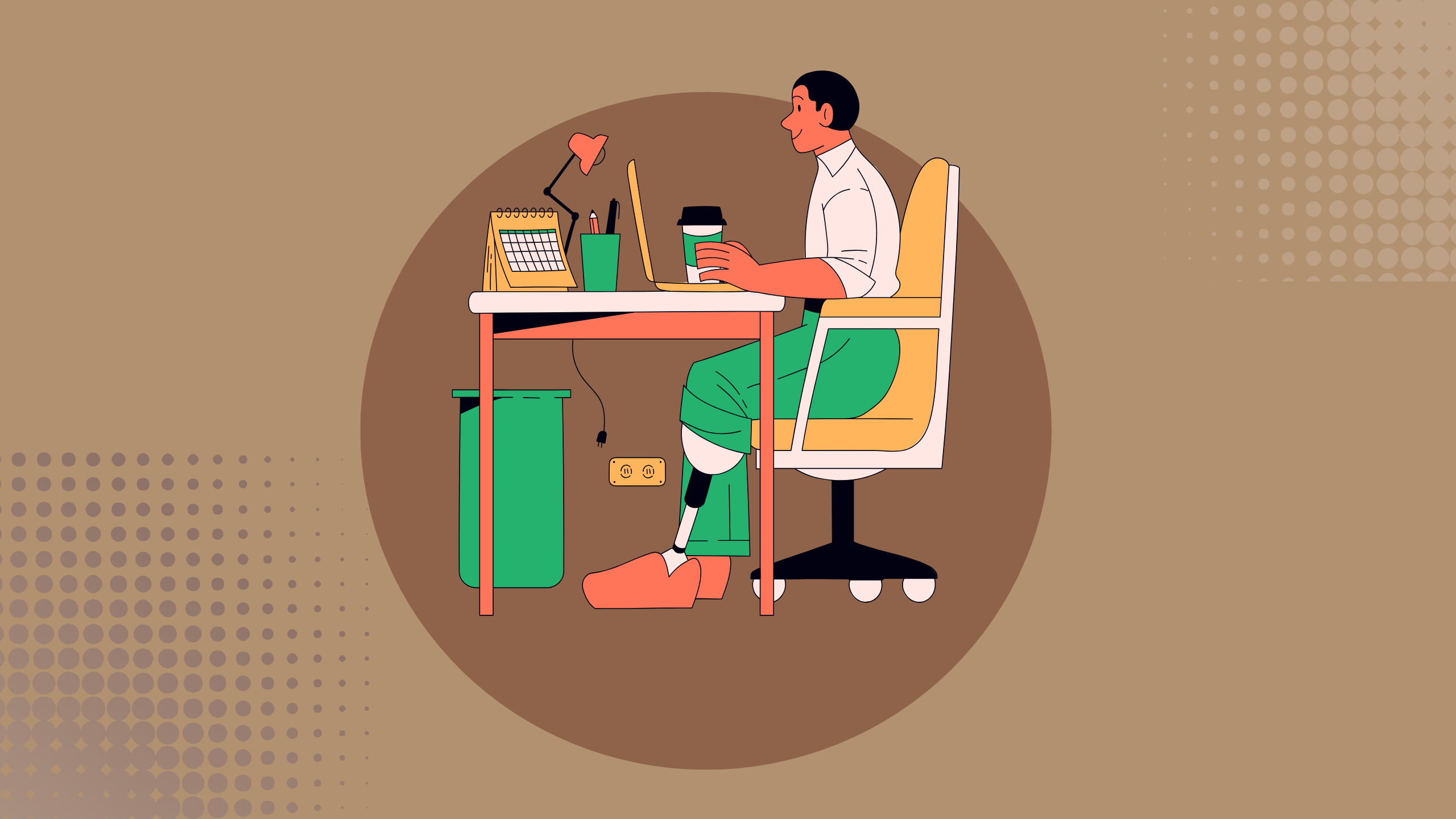Working from home might look ideal on the surface no long commutes, more flexibility, and the freedom to build your own schedule. But behind the perks, there’s a side of remote work that rarely gets talked about upfront: loneliness.
You don’t always notice it right away. It sneaks in between tasks, settles in during quiet afternoons, and slowly becomes part of the routine. Without hallway chats, spontaneous lunch outings, or a shared workspace, the social side of work disappears. And for many remote workers, especially those living alone, that silence starts to take a toll.
Unlike burnout or overload, loneliness doesn’t usually come with a warning sign. It’s not dramatic, but it’s draining. It affects your mood, your energy, your motivation and if ignored, it can even lead to long-term mental health issues.
This post isn’t about giving up remote work. It’s about making it more human. Whether you’re new to working remotely or have been doing it for years, finding ways to stay connected is just as important as staying productive. Let’s talk about how you can do that without forcing awkward virtual happy hours or trying to be someone you’re not.
How to Prevent Loneliness While Working From Home
Working from home gives you the freedom to skip traffic, wear what you want, and design your own workspace. But it also comes with one major drawback: loneliness. Over time, the lack of in-person interaction can chip away at your motivation, mood, and mental health.
In fact, a 2022 survey by Statista found that 50% of remote workers said they experience loneliness at least once a week. And while remote work isn’t going anywhere, this issue isn’t something you should ignore.
So how do you prevent loneliness in remote work while still enjoying the flexibility it offers? Here are some realistic tips, guides, and tools that can help.
1. Build a Consistent Social Routine Outside of Work
One of the biggest mistakes remote workers make is assuming social connection will just “happen.” Without an office environment, you’re no longer running into people naturally so if you don’t schedule it, it usually doesn’t exist.
The key here isn’t spontaneity. It’s routine. Just like you show up to work at a certain time each day, you should treat social connection as a part of your weekly structure not something that only happens when you’re feeling low.
Start small: commit to one or two recurring social commitments each week. That could mean grabbing chai with a neighbor every Saturday, joining a weekly badminton game, or attending a recurring local event like a comedy open mic or community class. The goal isn’t to be busy every evening it’s to make human connection a built-in part of your life.
If in-person isn’t always an option, try keeping a “social calendar” with planned phone or video chats with close friends. The point is predictability. Knowing you have that call every Friday or that walk every Wednesday gives you something to look forward to and helps break the monotony that often fuels remote work loneliness.
Even short, regular interactions can help ground your week. It’s not about filling time. It’s about creating balance something that remote work often blurs if you’re not careful.
When your job no longer includes casual conversations, lunch breaks with coworkers, or walking to grab coffee, you need to intentionally create those moments elsewhere.
Tips:
- Schedule weekly catch-ups with friends or family even a quick 10-minute call can help.
- Try joining local meetup groups through Meetup.com or Eventbrite.
- Block off time in your calendar for social activities, just like meetings.
Even short social interactions help reduce feelings of isolation. You don’t need to be an extrovert consistency matters more than quantity.

2. Use Virtual Coworking Spaces
Working from home can easily turn into working alone, and over time that can mess with your sense of structure. Virtual coworking helps fix that not by adding more meetings, but by giving you a space to work with people, not just near them.
Think of it like the digital version of sitting at a table in a quiet café where everyone’s doing their own thing, but you’re not alone. You log in, say a quick hello, and then everyone gets to work. There’s no pressure to talk, and you don’t have to be “on” like in a Zoom meeting. But you still feel a sense of presence and that matters.
It’s especially helpful if you struggle to start tasks or stay focused throughout the day. Having someone on the other side of the screen can give you just enough accountability to get going. It also adds a bit of structure to your day, which often goes missing when you’re not reporting to a physical office.
If you’re not ready to try a full platform, even setting up a simple co-working session with a friend over Google Meet or WhatsApp video can make a difference. You don’t need a paid app to recreate that “working side-by-side” energy.
Over time, these small habits can make a big dent in the isolation remote work sometimes brings. You’ll feel more connected even without saying much at all.
You’re not alone in feeling alone. Many remote workers are looking for accountability and companionship during work hours. Virtual coworking solves this.
Try:
- Focusmate – match with a live partner for body-doubling sessions.
- Caveday – facilitated deep work sessions with other remote professionals.
- Groove – pair up with others for short work sessions.
These platforms help mimic the feeling of “working alongside someone,” which can improve focus while helping to prevent loneliness in remote work.
3. Make Slack or Discord More Than Just Work
If the only messages you’re sending on Slack or Discord are task updates and meeting reminders, it’s no surprise you’re feeling disconnected. These platforms were built for communication but that doesn’t mean every message has to be about work.
What helps is treating your team’s workspace a little like a digital break room. You’re already there so why not use it to share a meme, drop a weekend pic, or post a “what are you watching lately?” question in a random channel? It doesn’t need to be overly curated or forced. Just real, casual stuff.
If you’re a manager or team lead, set the tone early. When leaders show that it’s okay to talk about non-work topics, others feel more comfortable doing the same. And no, this doesn’t mean spamming everyone with cat GIFs it’s about creating space for natural, low-stakes interactions.
Also, think about how you’re using status updates. Instead of “Working on presentation,” try something like “Deep in slides, send help 🧠☕.” Tiny shifts like that can make communication feel more human.
You can also set up lightweight rituals: Friday wins, midweek music shares, or even a rotating “question of the week.” None of it has to be time-consuming. But it reminds your team and yourself that work isn’t just deliverables. It’s also people.
If you’re part of a remote team, don’t treat chat tools like they’re just for status updates.
Actionable Ideas:
- Start non-work channels like #book-club, #weekend-plans, or #pets.
- Use video for weekly team meetings to stay visually connected.
- Schedule casual drop-in Zoom rooms during lunch hours.
Some remote-first companies like Buffer and Zapier actively encourage this and it’s part of why they report high employee satisfaction.
Read Also: 7 Smart Ways to Organize Remote Work Schedule with Google Calendar
4. Work From a Shared or Public Space Occasionally
There’s a weird comfort in being surrounded by strangers who are all doing their own thing. You’re not talking to them, but just being around people can lift your mood more than you’d expect especially when you’re used to working in silence day after day.
Working from home every single day can turn into a loop that’s hard to break: same chair, same view, same coffee cup. Taking your laptop to a shared or public space every now and then breaks that routine just enough to reset your brain. You get a change of pace, and that helps more than you might think.
It doesn’t have to be a fancy coworking space either. A quiet café, your local library, or even a college campus food court can do the job. Anywhere that has decent Wi-Fi and some buzz in the background is a good bet. You’re not going there to be social you’re just showing up somewhere that reminds you the world exists outside your four walls.
And if you do find a spot that clicks with you, make it a regular part of your week. Maybe every Thursday becomes your café day. Having that to look forward to can help make the rest of your week feel less isolated.
It’s not about pretending to have a social life. It’s about giving yourself the option to be around life, even if you’re just answering emails and knocking out to-do lists.
If you can work from anywhere, don’t always choose your couch.
Try:
- A local coworking space (WeWork, IndiQube, or 91Springboard in India).
- A quiet café with good Wi-Fi.
- Public libraries (many now offer work-friendly setups).
Changing your environment once or twice a week can reset your brain and help you feel connected to the outside world.

5. Check In With Your Mental Health
One of the hardest parts about working remotely is that it’s really easy to hide how you’re doing not just from others, but from yourself. You’re not bumping into coworkers who might notice something’s off. No one’s asking how your weekend was in the hallway. So if you’re not careful, you can go weeks feeling low without even realizing it.
That’s why regular check-ins with yourself matter. Not the vague “I think I’m fine” kind, but real moments where you pause and ask: How am I actually feeling today? Tired? Lonely? Burned out? Motivated? Even just naming what’s going on can help make it easier to handle.
It doesn’t have to be deep or dramatic. Maybe once a week, you take 10 minutes to jot a few thoughts in a notebook. Or you use a mood tracker app. Or you just sit with a coffee and reflect no phone, no screen. The goal is to be honest with yourself before things start to spiral.
And if things are feeling heavy, don’t wait for a breaking point to deal with it. Talk to someone. That might mean a therapist, but it could also be a friend, mentor, or coworker you trust. Mental health isn’t something you only deal with when it’s a crisis it’s something you keep an eye on, like your physical health.
You don’t get a badge for toughing it out alone. You’re allowed to need help, and you’re definitely allowed to say, “Something feels off, and I want to do something about it.”
Loneliness isn’t just about physical isolation it affects your mental well-being. Remote workers are more prone to anxiety and depression if they don’t proactively manage it.
Stats:
According to a 2021 survey by FlexJobs, 75% of remote workers said they experienced burnout, and over 40% linked it directly to isolation.
What Helps:
- Journaling (try apps like Day One).
- Talking to a mental health professional via BetterHelp or TherapyRoute.
- Practicing mindfulness with Headspace or Insight Timer.
6. Attend Online Communities That Aren’t Just Work-Related
When your only online interaction is tied to deadlines, to-dos, or task comments, your brain starts to associate the internet with work mode only. That’s a fast track to burnout and a missed opportunity.
The truth is, some of the best online connections come from places where no one cares about your job title. Whether it’s a group for film lovers, a subreddit about home workouts, or a Discord server for people who collect vintage keyboards, those non-work spaces matter. They remind you that you’re more than your job and give you room to breathe a little.
You don’t have to be a power user or spend hours chatting. Just dipping into a thread or joining a casual conversation can be enough to feel part of something outside your inbox. Plus, you’ll find people who geek out over the same things you do and that kind of connection is hard to find if you’re only interacting with coworkers.
And here’s the bonus: showing up in these spaces often leads to genuine friendships. Not networking. Not forced “engagement.” Just people sharing stuff because they care about it.
So if your day feels a little flat or you’re stuck in your head, spend ten minutes scrolling through a hobby forum, commenting on a niche thread, or joining a low-key livestream. It’s not a waste of time. It’s a reset button your brain probably needs more often than you think.
Working alone doesn’t mean being socially alone. You can still connect with like-minded people online.
Great Communities:
These spaces are great for chatting, problem-solving, or just feeling part of a group that understands remote work life.

7. Design a Workday With Real Human Breaks
When you’re working from home, it’s surprisingly easy to forget that you’re allowed to take a proper break. Not the kind where you scroll Instagram for five minutes and call it rest but actual moments where you pause, step away, and connect with something (or someone) that isn’t a screen.
Real human breaks mean giving yourself space to reset without multitasking. Instead of cramming lunch in while answering emails, what if you called a friend, sat on your balcony, or just listened to music and stared out the window for a bit? These moments sound simple, but they change how the rest of your day feels.
And here’s the thing: breaks that involve people, even in small ways, tend to give more energy than those that don’t. A 10-minute call with someone you like will almost always feel better than 10 minutes of mindless scrolling. You don’t need a deep conversation just a little social spark.
Also, try building in a few “transition” points during your day. Not every break has to be scheduled like a meeting, but having a loose rhythm helps. Maybe you call your sibling after lunch every Tuesday or meet a neighbor for a short evening walk a couple of times a week. It doesn’t have to be daily it just has to exist.
The goal isn’t to be more productive. It’s to feel more human in the middle of your workday. That’s what keeps the isolation from creeping in when no one else is around to pull you out of it.
If your workday feels like one long Zoom call or worse, complete silence you need better break design.
Try this break routine:
- 10 AM: Step out for a walk or balcony break.
- 1 PM: Lunch away from your desk (bonus if it’s with someone).
- 3:30 PM: 15-minute coffee + call a friend or parent.
Even scheduling small social moments helps prevent the slide into emotional detachment, especially for solo remote workers or freelancers.
Read Also: The Only Google Keep Productivity Tutorial You’ll Need to Boost Focus and Clarity
8. Be Honest With Your Team About Burnout
Burnout doesn’t always show up as exhaustion or frustration. Sometimes it just looks like logging off and thinking, I don’t care anymore. If you’ve been working remotely for a while, you’ve probably had days like that and you’re not the only one.
The problem is, remote work makes it easy to hide how you’re feeling. You can show up to Zoom calls, respond to emails, and still be running on fumes. That’s why speaking up matters not for drama, not to dump your stress on others but to give your team a chance to support you before things go sideways.
Being honest doesn’t mean giving your manager a full emotional download. It can be as simple as saying, “I’ve been feeling off lately maybe a little burned out,” or “I’m not quite myself this week, just need to reset a bit.” Most decent teams won’t see that as weakness they’ll appreciate the clarity.
And if you’re in a leadership role, your honesty matters even more. When people see that you’re willing to acknowledge your limits, it creates space for others to do the same. That’s how you build a team culture where people actually take care of themselves, not just say they will.
You don’t have to wait until you’re completely drained to speak up. The earlier you flag what you’re feeling, the easier it is to course-correct whether that’s taking a real break, shifting priorities, or just getting a little breathing room.
If you’re employed remotely, talk to your manager or HR if loneliness is affecting your work. You don’t need to overshare just being transparent about needing more team interaction is often enough to spark change.
Ask for:
- More frequent video calls.
- Pair work or collaborative projects.
- Virtual team-building sessions (games, workshops, etc.).
A good team will listen and it helps prevent loneliness in remote work from becoming a serious issue.
Read Also: 10 Expert-Approved Work-Life Balance Tips for Remote Workers with Busy Schedules
Conclusion: Don’t Wait Until You Feel It
One of the toughest parts of remote work loneliness is that it creeps in slowly. You may not notice it at first, but it builds. The earlier you create systems, routines, and support networks, the easier it becomes to manage.
Working remotely shouldn’t mean working in isolation. You have more options now than ever make use of them.




